27 September 2019, Kigali – The Global Green Growth Institute (GGGI) in collaboration with the Rwanda Housing Authority (RHA) celebrated World Green Building Week 2019 in Rwanda from 23 – 29 September. The World Green Building Week organized by the World Green Building Council is an annual campaign that motivates and empowers everyone to deliver green buildings. This year’s campaign aimed at raising greater awareness of the carbon emissions from all stages of a building’s lifecycle and encouraging new practices and new ways of thinking to work towards reducing carbon emissions from buildings.
In line with the theme of the week, RHA in collaboration with GGGI organized a site visit to Rwanda Institute for Conservation Agriculture (RICA) campus located in Bugesera District. A project conceptualized and funded by the Howard G. Buffett Foundation, and supported by the Government of Rwanda, RICA was designed by MASS Design Group and constructed by the Remote Group.
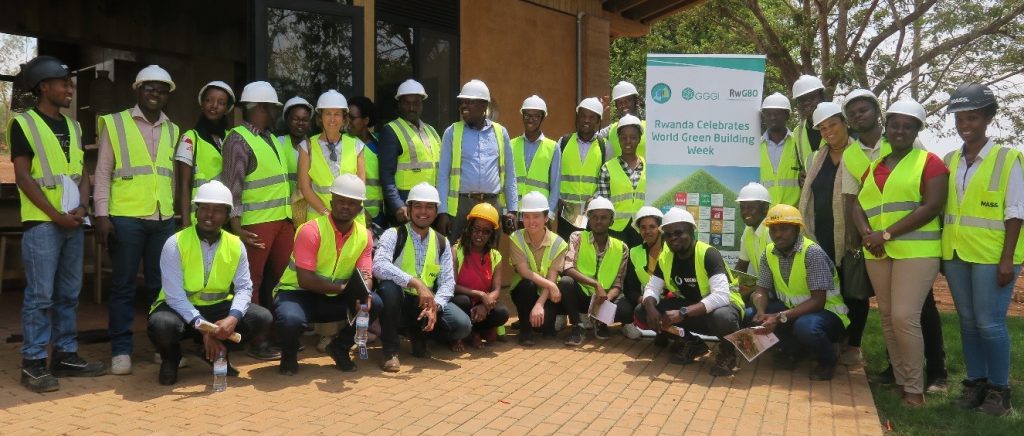
Group of participants at the RICA campus
Participants of the site visit included representatives from several Rwandan government and non-government institutions involved in the building and construction sector such as the Ministry of Infrastructure (MININFRA), Rwanda Housing Authority (RHA), GGGI, Rwanda Environment Management Authority (REMA), City of Kigali (COK), Rwanda Institute of Architects (RIA), Institution of Engineers Rwanda (IER), University of Rwanda, School of Architecture and Built Environment (UR-SABE), Integrated Polytechnic Regional College (IPRC) Kigali, Ultimate Developers Limited (UDL), Green Pact Africa and Rwanda Green Building Organization (RwGBO)
MASS Design team provided an overview of the campus master planning, architecture and design and shared information on the low-carbon green building materials, construction techniques and green technologies used in the project followed by a guided tour of the campus. Some of the unique low-carbon green building features of the RICA campus are:
1) Compressed Stabilized Earth Block (CSEB) walls made by utilizing the soil from the project’s site,
2) Rammed earth wall – a low carbon technique that uses material directly from site and produces a wall with high thermal mass that help keep the building cool;
3) Timber roof structure from timber plantations in Rwanda;
4) Clay roof tiles that use local clay and fired using agricultural waste to keep the heat outside and to reduce the noise from rain;
5) The entire campus furniture (for classrooms, student hostel and faculty quarters) is manufactured locally using locally produced timber and furniture is made by local craftsmen and women ;
6) 1.5 MW Solar Farm with battery storage system to meet 100% of campus energy requirements;
7) On-site potable water treatment plant and waste water treatment plant to name a few.
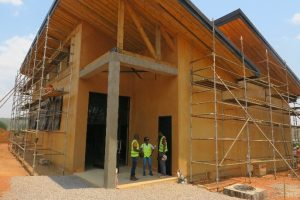
Figure 2: CSEB Wall plastered with soil
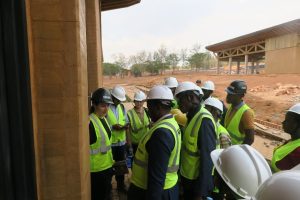
Figure 3: MASS Design representative sharing details of Rammed Earth wall construction
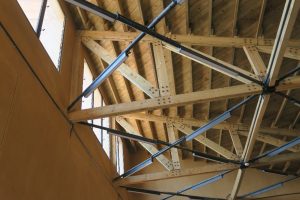
Figure 4: Timber roofing
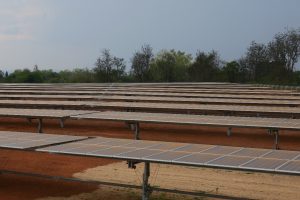
Figure 5: 1.5MW Solar farm with battery storage system
Through a combination of the above low-carbon and green building design features RICA project’s embodied carbon stands at 175 kgCO2eqvivalent/sq. m which is 2/5th of the global average for education buildings. Embodied carbon is associated with materials and construction processes throughout the whole lifecycle of a building or infrastructure. Embodied carbon typically includes material extraction, transport to manufacturer, manufacturing, transport to site, construction, use phase, maintenance, repair, end of life and disposal.
According to the International Energy Agency (IEA) and the United Nations Environment (UNE) 2018 Global Status Report, globally building construction and operation account for 39% of energy-related CO2 emissions in 2017. 28% of these emissions come from the operational “in-use” phase – to heat, power and cool them, while 11% of these emissions are attributed to embodied carbon emissions.
To promote green buildings in Rwanda, the Government of Rwanda approved the Rwanda Green Building Minimum Compliance System which is an Annex to the Ministerial Order determining Urban planning and Building regulations along with the revised Rwanda Building Code. GGGI is currently supporting RHA in the rollout of the minimum compliance system.
During the green building week, several individuals representing government and non-government institutions from Kigali and secondary cities of Rwanda have taken a green building pledge and shared their contribution for building a better future.
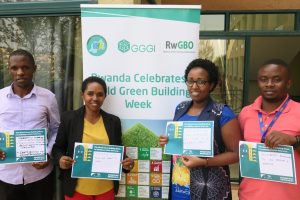
Figure 6: after site visit , participates make their pledges to building a better future.
A social media campaign was organized to raise the importance and awareness of green buildings via GGGI twitter handle, follow the discussion online https://twitter.com/GGGI_Rwanda
To access Rwanda Green Building Minimum Compliance System, please follow link :https://gggi.org/report/rwanda-green-building-minimum-compliance-system/